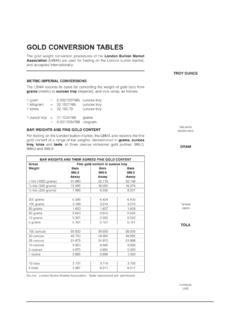Transcription of Soldering to Gold- A Practical Guide - Solder …
1 1 Soldering to gold - A Practical Guideby Ronald A. BulwithBackground/HistoryGold has always seemed to find a place in electronic applications because of thevery versatile characteristics it possesses. Historically, it has been used as an etch resist,contact surface finish, protective coating, wire bondable surface finish, die attach surface,and solderable has been in the role of a solderable coating where some confusion andmisconception has always existed. The misunderstandings have been with respect to theimpact of Au on the Soldering processes, along with the resultant effects on the propertiesof the Solder connections the past, the average thicknesses of applied Au deposits were much greater thanthose currently being applied.
2 In most cases, this was specifically related to the particularapplication and plating solution. Some applications required harder, fine grained depositswhere the use of codeposited hardening elements, grain refining additives, andbrighteners were necessary. In these applications, smooth, shiny, thinner coatings weregenerally applied ( 30m-inches). These types of coatings were generally applied tocontact surfaces and to areas requiring overall environmental protection. In otherapplications, Au deposits with either no additives, or low levels of additives, wererequired in order to attain the required properties for the specific application. Therougher, duller, matte finish of such Au deposits was found to be an advantage in directdie attach and wire bonding to devices utilizing leadframes in their construction.
3 Insituations such as these, the Au thicknesses were sometimes fairly substantial ( 30m-inches).In most of the aforementioned applications, very little consideration was given tothe subsequent Soldering operations to which these components would be subjected. As aconsequence, these relatively thick Au coatings would not only be deposited in the areasrequired for the specific application,but also to areas to which solderconnections would afterward bemade. Even when applied as asolderability preservative coating,thicker layers were necessary toensure adequate solderabilityprotection, due to the inherentporosity of the , Soldering tothese thick Au deposits, generally inthe 30 m-inch to 100 m-inch range(Figure1), resulted in somecommonly associated problems.
4 Poor solderability andFigure 1-Very thick Au deposit which will undoubtedlyresult in poor Solder embrittlement became very commonly used terms, when Soldering to these Au was these undesirable characteristics, along with the swiftly rising market price of Authat ultimately resulted in it s demise, until recently, as a popular electronic in the Use of AuDue to the expanding use of Au over past several years, it has become clear thatthe troublesome issues previously described, require some clarification. This is especiallyimportant for those faced with the task of creating Solder connections to surfacespossessing Au finishes, as well as those who specify, design and deposit the Au intended objective of this paper is as follows.
5 To bring some clarification to many of the issues surrounding the process ofsoldering to Au To bring about a better understanding of the process and the connections therebyproduced Lastly, to propose some helpful considerations and guidelines that will result inmore reliable, functional Solder connections with greater longevityThickness is the KeyAfter many years ofperforming metallographic failureanalyses of Solder connectionsinvolving Au coatings, it has becomeclear that thickness is the mostinfluential characteristic of the Audeposit as it relates to the ultimateintegrity of the Solder , most currentapplications use very thin deposits, inthe range of 5 m-inch to 15 m-inchthicknesses (Figure2). The emergenceof plating processes that producedenser, less porous deposits, alongwith the reduction of time betweenapplication of the deposits and actualassembly Soldering , have allowed processors to attain adequate solderability thinner, less porous Au deposits are extremely important for Adequate solderability protection at a lower cost2.
6 Lower probability of Solder connection embrittlement3. Reduced voiding in Solder connectionsFigure 2- Thin Au deposit that is in the rangecurrently most acceptable for minimization ofsoldering Reduced localized Sn depletionEach of the aforementioned reasons is individually significant and will thereforebe addressed ProtectionSince the actual Solder bond is being made to the underlying layer (typically Ni)following the rapid dissolution of the Au, the good solderability of that layer (assuming itwas originally present) will be preserved by the thinner, denser, lower porosity of the very rapid dissolution of the thin Au coating, and the subsequentformation of the Solder bond to the Ni, it is of paramount importance that the Ni surfacebe made active and solderable immediately prior to application of the Au deposit.
7 If theNi surface was not solderable at that point, deposition of the Au solderability preservativecoating will have been made in vain (Figure 3). It is amazing how this seemingly obviouspoint can be overlooked due to either misunderstanding, or lack of communication withthose responsible for the electroplating process (see the following Plating Practices section). It is important to make it understood that solderability must be initially present,if it is to be preserved by aprotective coating. This is not onlytrue in this situation, but in allthose where a solderabilitypreservative coating is aware that the solderconnection is being made to theNi, it is also important to be awarethat, even when solderable, Nireacts much slower with solderthan Cu ( 1 ), therefore, requiringmore energy to create an adequatebond.
8 This is important tounderstand when considering asolder paste reflow profile for SMattach. Additional time above Solder alloy liquidus temperature must be factored into theoperation ( 2 ) in order to achieve the required reaction between the Ni and the Sn in with most materials to which Solder connections are created, the Ni must alsoreact sufficiently with the Sn in the Solder , to form a continuous intermetallic compound(IMC) layer at their interface. The necessary Ni-Sn IMC reaction layer formation isessential to create a Solder connection with sufficient strength to withstand the requiredservice rigors encountered in it s role as part of the complete 3- Dewetting of Au plated SM attachment sites dueto poor solderability of underlying PracticesIn addition to the obvious need forgood solderability, the impurity levels inthe Ni deposit should be kept as low aspossible.
9 This is important, even when P-Ni electroless deposits are used. Anyimpurities, either codeposited or occluded,that do not take part in the bondingreaction, could accumulate at one of thereaction interfaces, and interfere with thereaction, reducing the actual anchorage areacreated during the reaction. This clearlywill reduce the overall strength of the bondbeing created and have an impact on it sservice life and that of the assembly ofwhich it is a integral member. It is thereforesuggested that plating solutions be maintained and filtered regularly so as to minimize thecodeposition and/or occlusion of unwanted contaminants. In the case of P in electrolessP-Ni, keeping the P content nearer it s lower limit will be an advantage in this respect(Figure 5).
10 Interruptions in the Ni deposition process, resulting in a layered deposit, willalso create weaknesses that can eventually be failure sites (Figure 6).EmbrittlementThe advantage of thinner Au deposits is also important from the standpoint ofsolder connection embrittlement. The thinner Au deposits minimize Au-Sn IMCformation, and in almost all instances, its concentration along the reaction interface(Figure7). In situations where thick Au deposits (>20 m-inches) are present, the largerquantity of Au-Sn IMC that forms, usually segregates and cannot disperse uniformlyFigure 4- Failure within layered and impurityembrittled Ni 5- Failure due to separation at interfacebetween Ni-Sn IMC layer and Ni deposit caused byaccumulation of contaminants during 6- Failure initiating within layered andimpurity embrittled Ni the Solder connection.








